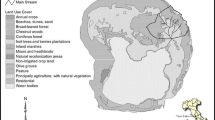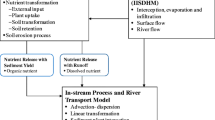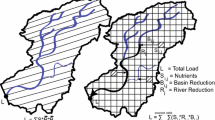Abstract
This paper presents a newly-derived method for directly determining the amount of transported dissolved phosphorus by water erosion. The results of the method are compared to prediction based on enrichment ratio (as proposed by Sharpley) and average share of dissolved phosphorus (DP) in total transported phosphorus (5%) that is widely used in the Czech Republic. Four study areas (catchments of dozens of sq. kilometer) were chosen for their different characteristics (land use, average slope, average elevation, phosphorus concentration in the soil) which influence their rainfall-runoff behavior. The modeled results are compared with data measured in situ. The two methods provide similar results in intensively agriculturally used regions. Agreement among the methods was observed for three study areas with significant erosion intensity (above 4 t/ha/year). In the catchment with significantly lower erosion intensity (0.5 t/ha/year), the indirect method (Sharpley) underestimates the amount of DP transported in the watercourses. The sum of transports of suspended solids into watercourses and the average available phosphorus content in the soil determined by the Mehlich 3 method (PM3) are the main factors influencing the results provided by the two methods. An analysis of the impact of these factors on the difference between the results of the methods was provided. Transport of suspended solids is related to the method difference (R range from 0.37 to 0.71). However, no significant relationship was found between the difference in the results and the average PM3 content in the soil (R range from 0.15 to 0.36).




Similar content being viewed by others
References
Bacova, M., & Krasa, J. (2016). Application of historical and recent aerial imagery in monitoring water erosion occurrences in Czech highlands. Soil and Water Research, 11(4), 267–276.
Boar, R. R., Lister, D., & Clough, W. T. (1995). Phosphorus loads in a small groundwater-fed river during the 1989-1992 East Anglian drought. Water Research, 29, 2167–2173.
Borovec, J., Jan, J., Hejzlar, J., Krasa, J., Rosendorf, P. (2012). Eutrophication potential of eroded particles in water reservoirs. In: Proceedings of conference water reservoirs 2012. Kosour D (ed) Brno, The Czech Republic 57–61. (in Czech).
Caldwell, M. M., Richards, J. H., Manwaring, J. H., & Eissenstadt, D. M. (1987). Rapid shifts in phosphate acquisition show direct competition between neighbour plants. Nature, 327, 615–616.
Davidova, T., Dostal, T., David, V., & Strauss, P. (2015). Determining the protective effect of agricultural crops on the soil erosion process using a field rainfall simulator. Plant Soil Environment, 61, 109–115.
Dendy, F. E., & Champion, W. A. (1978). Sediment deposition in U.S. reservoirs. Miscellaneous publication no. 1362. Washington, DC: USDA.
Desmet, P. J. J., & Govers, G. (1996). A GIS-procedure for automatically calculating the USLE LS-factor on topographically complex landscape units. Journal of Soil and Water Conservation, 51(5), 427–433.
Diebel, M. W., Maxted, J. T., Robertson, D. M., Han, S., & Zanden, M. J. Z. (2009). Landscape planning for agricultural nonpoint source pollution reduction III: assessing phosphorus and sediment reduction potential. Environmental Management, 43(1), 69–83.
EC. (2000). Directive 2000/60/EC of the European Parliament and of the Council of 23 October 2000 establishing a framework for community action in the field of water policy. Official Journal of the European Union, 327, 1–73.
Fiala, D., & Rosendorf, P. (2009). Diffuse phosphorus sources in the catchment of the Orlik water reservoir. In I. Ocaskova (Ed.), Orlik water reservoir revitalization (pp. 75–86). Pisek: The Institute of Technology and Business in Ceske Budejovice (in Czech).
Hahn, C., Prasuhn, V., Stamm, C., & Schulin, A. R. (2012). Phosphorus losses in runoff from manured grassland of different soil P status at two rainfall intensities. Agriculture, Ecosystems and Environment, 153, 65–74.
Hillel, D. (2008). Soil in the environment: crucible of terrestrial life. New York, USA: Academic Press/Elsevier.
Horst, W. J., Kamh, M., Jibrin, J. M., & Chude, V. O. (2001). Agronomic measures for increasing P availability to crops. Plant and Soil, 237, 211–223.
Hou, X., & Bradley, T. J. (2000). Inductively coupled plasma/optical emission spectrometry. In R. A. Meyers (Ed.), Encyclopedia of analytical chemistry (pp. 9468–9485).
Jan, J., Borovec, J., Kopacek, J., & Hejzlar, J. (2013). What do results of common sequential fractionation and single-step extractions tell us about P binding with Fe and Al compounds in non-calcareous sediments? Water Research, 47(2), 545–557.
Janotova, B., Krasa, J., Borovec, J., & Bauer, M. (2014). Phosphorus transport modelling by WaTEM/SEDEM using experimental data. In 14th Int. multidisciplinary scientific geoconference surveying geology and mining ecology management (pp. 131–138). Albena, Bulgaria: SGEM 2014.
Jordan-Miele, L., & Dorioz, J. M. (2004). Soluble phosphorus dynamics in agricultural watershed. Agronomie, 24(2004), 237–248.
Kavka, P., Strouhal, L., Jachymova, B., Krasa, J., Bacova, M., Laburda, T., Dostal, T., Devaty, J., Bauer, B. (2016) Double size fulljet field rainfall simulator for complex interrill and rill erosion studies. Agricultural Water Management. (under review).
Klement, V., & Susil, A. (2013). Results of agrochemical testing of agricultural soil for the period 2007–2012. Brno, Czech Republic: Central Institute for Supervising and Testing in Agriculture ISBN 978-80-7401-077-4. (in Czech).
Krasa, J. (2010). Empirical models of soil erosion by water in the Czech Republic—tools, data, challenges and risks of assessment. Habilitation thesis, Praha, CVUT, Department of Irrigation Drainage and Civil Engineering. (in Czech).
Krasa, J., Rosendorf, P., Hejzlar, J., Borovec, J., Dostál, T., David, V., et al. (2013). An assessment of the vulnerability of water reservoirs to sediment loads and eutrophication caused by soil erosion: certificated methodology for practice. Prague: CTU in Prague (in Czech).
Krasa, J., Dostal, T., Rosendorf, P., Borovec, J. (2015). Modelling of sediment and phosphorus loads in reservoirs in the Czech Republic. In M. A. Fullen et al. (Eds.), Advances in GeoEcology, 44, 21–34.
Kronvang, B., Behrendt, H., Andersen, H. E., et al. (2009). Ensemble modeling of nutrient loads and nutrient load partitioning in 17 European catchments. Journal of Environmental Monitoring, 11, 572–583.
Lowrance, R. R., Leonard, R. A., & Asmussen, L. E. (1985). Nutrient budgets for agricultural watersheds in the southeastern coastal plain. Ecology, 66, 287–296.
Mahmoodabadi, M., & Sajjadi, S. A. (2016). Effects of rain intensity, slope gradient and particle size distribution on the relative contributions of splash and wash loads to rain-induced erosion. Geomorphology, 253, 159–167.
Martinez-Mena, M., Alvarez-Rogel, J., Albaladejo, J., & Castillo, V. M. (1999). Influence of vegetal cover on sediment particle size distribution in natural rainfall conditions in a semiarid environment. Catena, 38, 175–190.
Millier, H. K., & Hooda, P. S. (2011). Phosphorus species and fractionation—why sewage derived phosphorus is a problem. Journal of Environmental Management, 92, 1210–1214.
Polakova, S., Kubik, L., Nemec, P., Maly, S. (2002). Basal monitoring of agricultural soils 1992–2007. Central Institute for Supervising and Testing Agriculture. Available at http://eagri.cz/public/web/file/242595/BMP92_01_prowww.pdf2010 (in Czech).
Schindler, D. J. (2012). The dilemma of controlling cultural eutrophication of lakes. Proceedings of the Royal Society, Biological Sciences, 279, 4322–4333.
Sharpley, A. N. (1980). The enrichment of soil phosphorus in runoff sediments. Journal of Environmental Quality, 9, 521–526.
Sharpley, A. N. (1985). The selection erosion of plant nutrients in runoff1. Soil Science Society of America Journal, 49, 1527–1534.
Sharpley, A. N. (1995). Dependence of runoff phosphorus on extractable soil phosphorus. Journal of Environmental Quality, 24, 920–926.
Sharpley, A. N., Smith, S. J., Jones, O. R., Berg, W. A., & Coleman, G. A. (1992). The transport of bioavailable phosphorus in agricultural runoff. Journal of Environmental Quality, 21, 30–35.
Sheklabadi, M., Mahmoudzadeh, H., Mahboubi, A. A., B. Gharabaghi a, & Ahrens, B. (2014). Land use effects on phosphorus sequestration in soil aggregates in western Iran. Environmental Monitoring and Assessment, 186(10), 6493–6503.
Shigaki, F., Sharpley, A., & Prochnow, L. I. (2007). Rainfall intensity and phosphorus source effects on phosphorus transport in surface runoff from soil trays. Science of the Total Environment, 373, 334–343.
Sims, J. T. (2000). Soil test phosphorus: Mehlich 3. In: Pierzynski eds. Methods of phosphorus analysis for soils, sediments, residuals, and waters. Southern cooperative series bulletin no. 396.
Strauss, P., Pitty, J., Pfeffer, M., Menter, A. (2000). Rainfall simulation for outdoor experiments. In: P. Jamet, J. Cornejo (ed): Current research methods to assess the environmental fate of pesticides. Pp. 329-333, INRA editions.
Strauss, P., Leone, A., Ripa, M. N., et al. (2007). Using critical source areas for targeting cost-effective best management practices to mitigate phosphorus and sediment transfer at the watershed scale. Soil Use and Management, 23(1), 144–153.
Toy, T. J., Foster, G. R., & Renard, K. G. (2002). Soil erosion: processes, prediction, measurement, and control. New York, USA: John Wiley and Sons, Inc..
Van Oost, K., Govers, G., & Desmet, P. (2000). Evaluating the effects of changes in landscape structure on soil erosion by water and tillage. Landscape Ecology, 15(6), 579–591.
Van Rompaey, A., Verstraeten, G., Van Oost, K., Govers, G., & Poesen, J. (2001). Modeling mean annual sediment yield using a distributed approach. Earth Surface Processes and Landforms, 26(11), 1221–1236.
Verstraeten, G., Van Oost, K., Van Rompaey, A., Poesen, J., & Govers, G. (2002). Evaluating an integrated approach to catchment management to reduce soil loss and sediment pollution through modeling. Soil Use and Management, 18, 386–394.
Vopravil, J., Janecek, M., & Tippl, M. (2007). Revised soil erodibility K-factor for soils in the Czech Republic. Soil and Water Research, 2, 1–9.
Wetzel, R. (2001). Limnology: lake and river ecosystems. San Diego, USA: Academic Press, Third Edition.
Wischmeier, W. H., & Smith, D. D. (1978). Predicting rainfall erosion losses—a guide to conservation planning. In Agr. handbook no. 537. Washington, DC: USDA.
Zhang, G. H., Liu, G. B., Wang, G. L., & Wang, Y. X. (2011). Effects of vegetation cover and rainfall intensity on sediment-bound nutrient loss, size composition and volume fractal dimension of sediment particles. Pedosphere, 21(5), 676–684.
Zumr, D., Dostál, T., & Devátý, J. (2015). Identification of prevailing storm runoff generation mechanisms in an intensively cultivated catchment. Journal of Hydrology and Hydromechanics., 63(3), 246–254.
Acknowledgements
This research has been supported by the following grants: SGS14/180/OHK1/3T/11 “Rainfall-runoff, erosion and transport processes—experimental research”, and QJ1330118 “Using Remote Sensing for Monitoring of Soil Degradation by Erosion”. The paper reports on results obtained within project QI102A265 “Assessment of soil erosion and phosphorus loads causing eutrophication of stagnant water bodies”. The authors would like to express their many thanks to RNDr. Jakub Borovec, from the Biology Centre of the Institute of Hydrobiology of the Czech Academy of Sciences, for providing valuable consultations, to Ing. Miroslav Bauer, from the Department of Irrigation, Drainage and Landscape Engineering, Faculty of Civil Engineering, Czech Technical University in Prague for his helpful cooperation on sediment and phosphorus transport modeling, and to Robin Arthur Healey for English assistance of this paper.
Author information
Authors and Affiliations
Corresponding author
Rights and permissions
About this article
Cite this article
Jachymova, B., Krasa, J. A new method for modeling dissolved phosphorus transport with the use of WaTEM/SEDEM. Environ Monit Assess 189, 365 (2017). https://doi.org/10.1007/s10661-017-6082-4
Received:
Accepted:
Published:
DOI: https://doi.org/10.1007/s10661-017-6082-4




